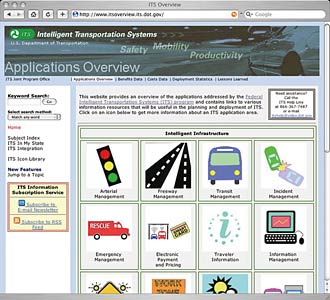Overseas News on Civil Engineering IT
|
|
This section focuses on unique overseas websites related to civil engineering IT in serial. This issue features "ITS Joint Program Office (ITS JPO)," which covers diverse Intelligent Transportation Systems (ITS) programs in the U.S. Department of Transportation (USDOT) in a cross-sectional effort.
Diverse ITS Programs Tackled by USDOT, Coordinated by ITS JPO in a Cross-sectional way
ITS, which integrates the state-of-the-art information, communications and electronics technologies into the transportation system's infrastructure and in vehicles themselves, is able to improve transportation safety and mobility and enhance productivity.
According to its website, USDOT ITS programs focus on intelligent vehicles and infrastructure; furthermore, they aim to create an intelligent transportation system through integration with and between these two components. Especially, the Federal ITS program backs the overall advancement of ITS up with investing in major initiatives, exploratory studies, and a deployment support program. So far, the Federal investments have been increasingly applied to major initiatives that are expected to be effective in improving safety, mobility and productivity.
In this context, the ITS Management Council reorganized the functions of the ITS program in 2004, focusing on nine particular high pay-off areas. The nine major initiatives are as follows; (1) Vehicle Infrastructure Integration (VII), (2) Next Generation 9-1-1, (3) Cooperative Intersection Collision Avoidance Systems, (4) Integrated Vehicle Based Safety Systems, (5) Integrated Corridor Management Systems, (6) Clarus (National Surface Transportation Weather Observing and Forecasting System), (7) Emergency Transportation Operations, (8) Mobility Services for All Americans, and (9) Electronic Freight Management.
The ITS Management Council's goal is to develop and direct Federal ITS policy and ensure the effectiveness of the ITS program. Therefore, its members comprise the Under Secretary of Transportation for Policy, the Assistant Secretary for Transportation Policy and Intermodalism, USDOT's Chief Information Officer and the Administrators of the Federal Highway Administration (FHWA), the Federal Motor Carrier Safety Administration (FMCSA), the Federal Transit Administration (FTA), the National Highway Traffic Safety Administration (NHTSA), the Research and Innovative Technology Administration (RITA), the Federal Railroad Administration (FRA) and the Maritime Administration (MARAD). In May 2006, the RITA Administrator became chair of the ITS Management Council. The ITS Strategic Planning Group gives advice to the ITS Management Council, and is chaired by the ITS program manager.
ITS JPO is located in FHWA for an administrative reason. Under the policy direction of RITA, it has Department-wide authority in coordinating the ITS program and initiatives relating FHWA, FMCSA, NHTSA, FRA, FTA and MARAD.
The website refers to the Intermodal Surface Transportation Efficiency Act of 1991 (ISTEA) as the beginning of the Federal ITS Program. Reflecting ISTEA, a Federal program was established aiming to research, develop, and operationally test ITS and to promote their implementation.
The program was designed to facilitate deployment of technology to enhance the efficiency, safety, and convenience of surface transportation, which brings about improved access, saved lives and time, and increased productivity. To foster the development of ITS, the program began with focusing on three different efforts such as (1) basic research and development, (2) operational tests that served as the bridge between basic research and full deployment, and (3) various deployment support activities that facilitated the implementation of integrated ITS technologies.
First, ISTEA originally authorized $659 million for fiscal years 1992-1997 with additional funds up to approximately $1.2 billion in total. Then, the Transportation Efficiency Act for the 21st Century (TEA-21) authorized nearly the same amount ($1.3 billion) through fiscal year 2003. In 2005, the Congress established the Safe, Accountable, Flexible, Efficient Transportation Equity Act: A Legacy for Users (SAFETEA-LU), which ended the ITS Deployment Program at the close of fiscal year 2005; on the other hand, it continued ITS research at $110 million annually through fiscal year 2009. Besides authorized ITS funding, ITS projects are qualified to obtain regular Federal-aid highway funding.
To Cover Various Information on ITS
The top page of the website widely lays out major menu items such as Current News, Federal Initiatives Focus, Technical Assistance Resources, Other USDOT Program Activities, and Decision Making Resources in the middle. Besides them, the side column also provides "Overview" to introduce the definition of ITS as well as information concerned in every state, "Focus Areas" to link major initiatives and program activities, "Foundational Framework" to explain architecture, standards and telecommunications, and Deployment Support to provide databases needed for ITS deployment.
For example, "Applications Overview" classifies the applications of ITS into 13 types of system on infrastructures and 3 on vehicles, 16 types of system in all. If you select any item, you will be able to get the graphic on each section of the ITS Taxonomy; in addition, they explain you clearly and visually.
 |
 |
 Top page: ITS Joint Program Office (ITS JPO), WSDOT (Reprinted by courtesy
of ITS JPO) Top page: ITS Joint Program Office (ITS JPO), WSDOT (Reprinted by courtesy
of ITS JPO) |
 The example of classified applications of ITS from "Applications Overview"
(Reprinted by courtesy of ITS JPO) The example of classified applications of ITS from "Applications Overview"
(Reprinted by courtesy of ITS JPO) |
This article is written based on the above website with the permission of ITS JPO.


